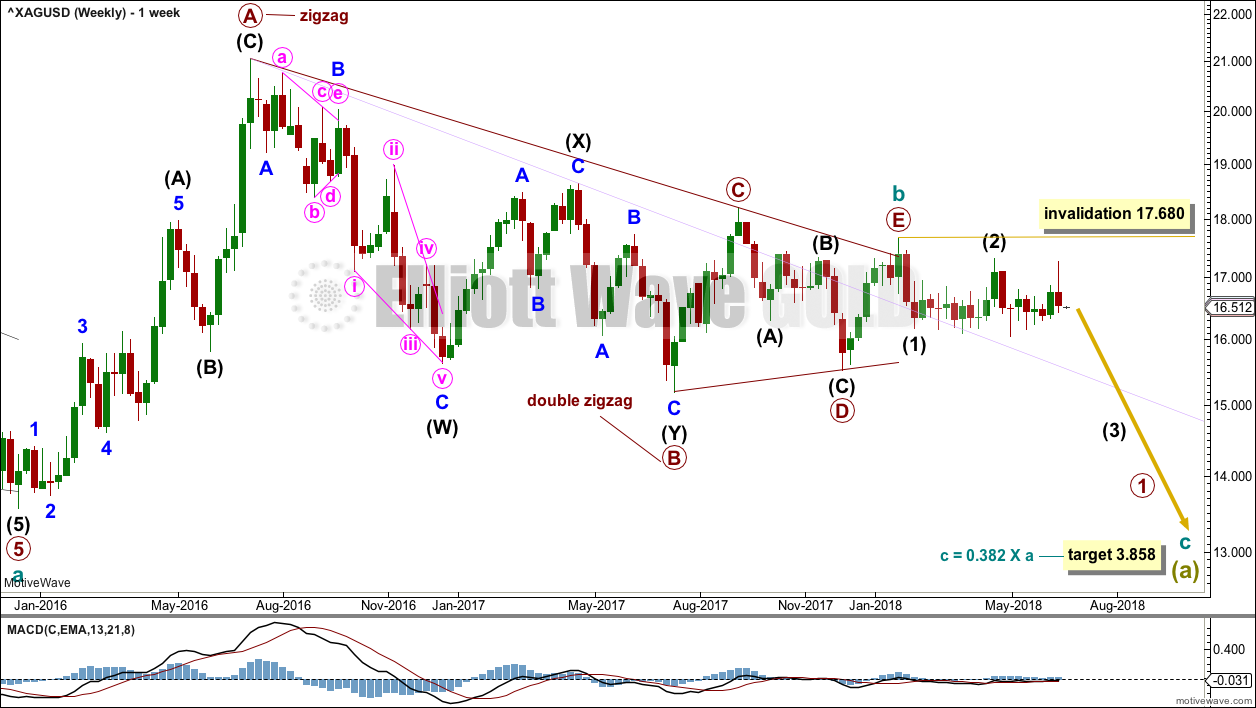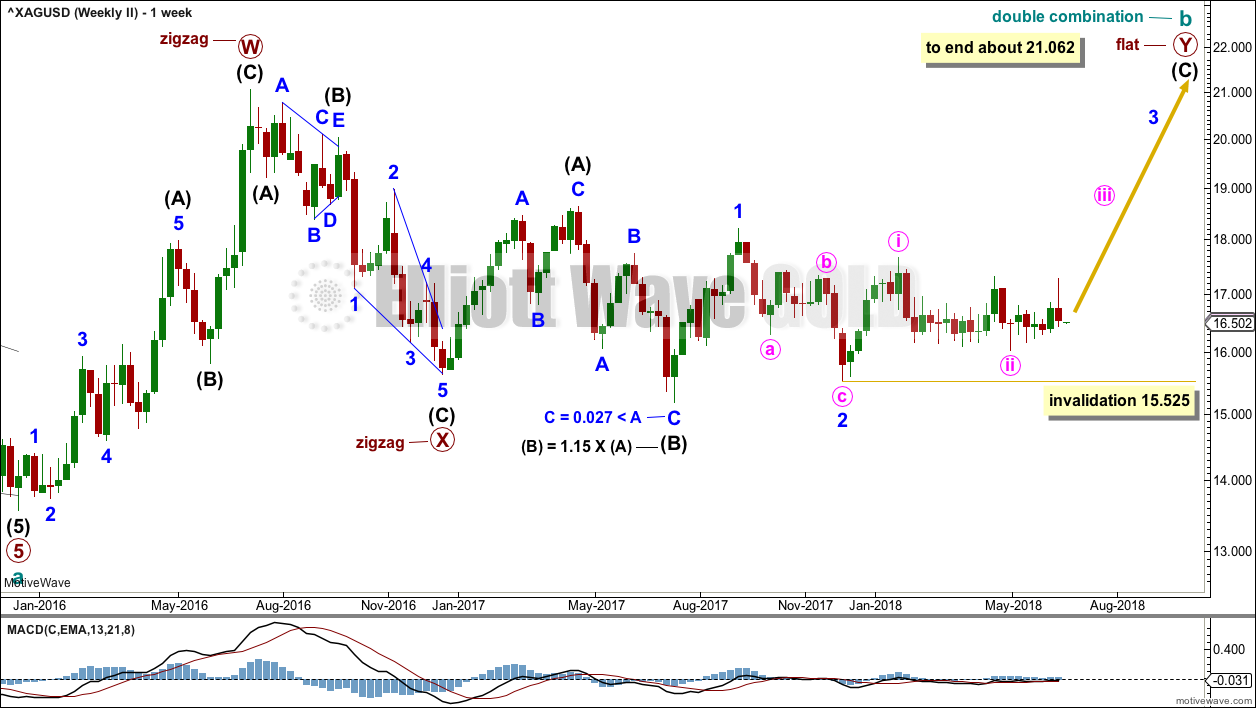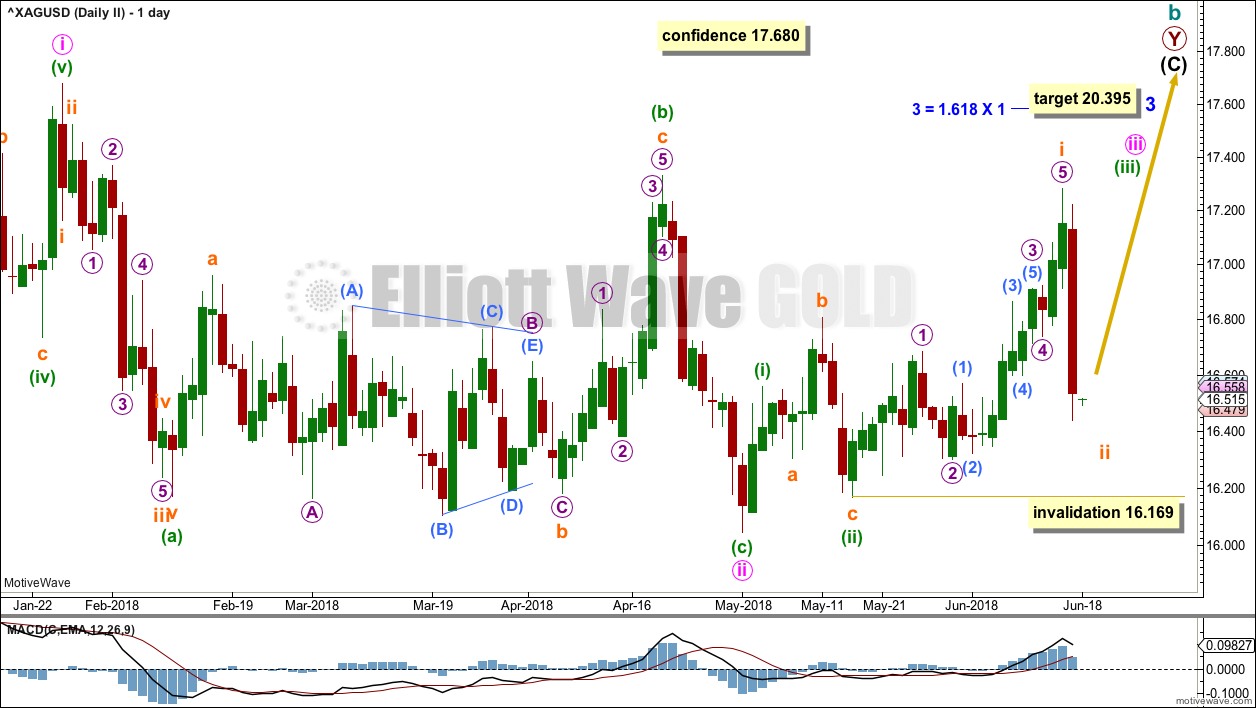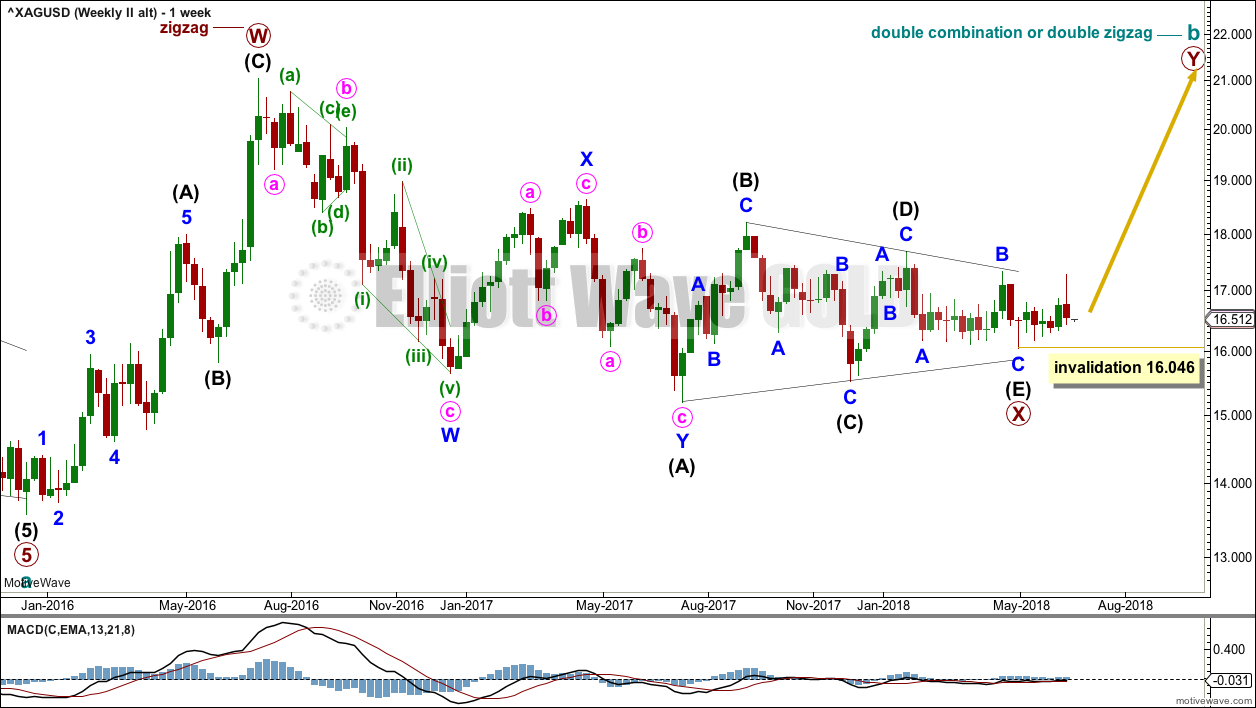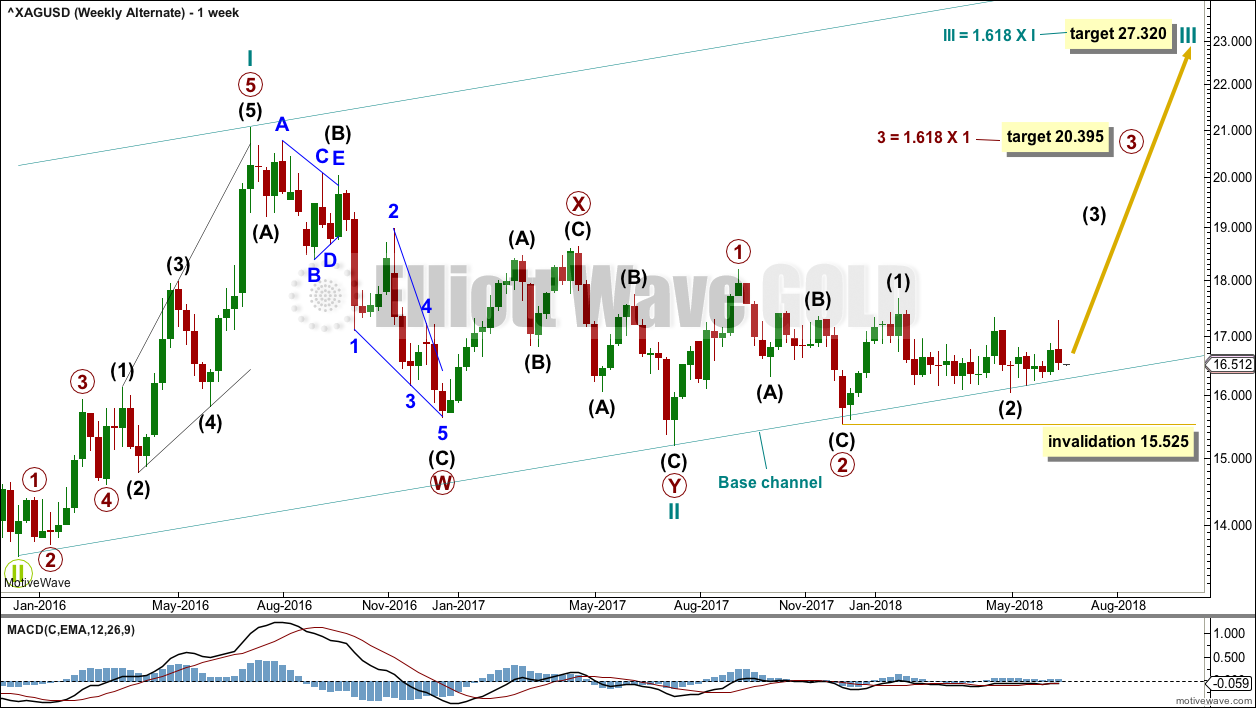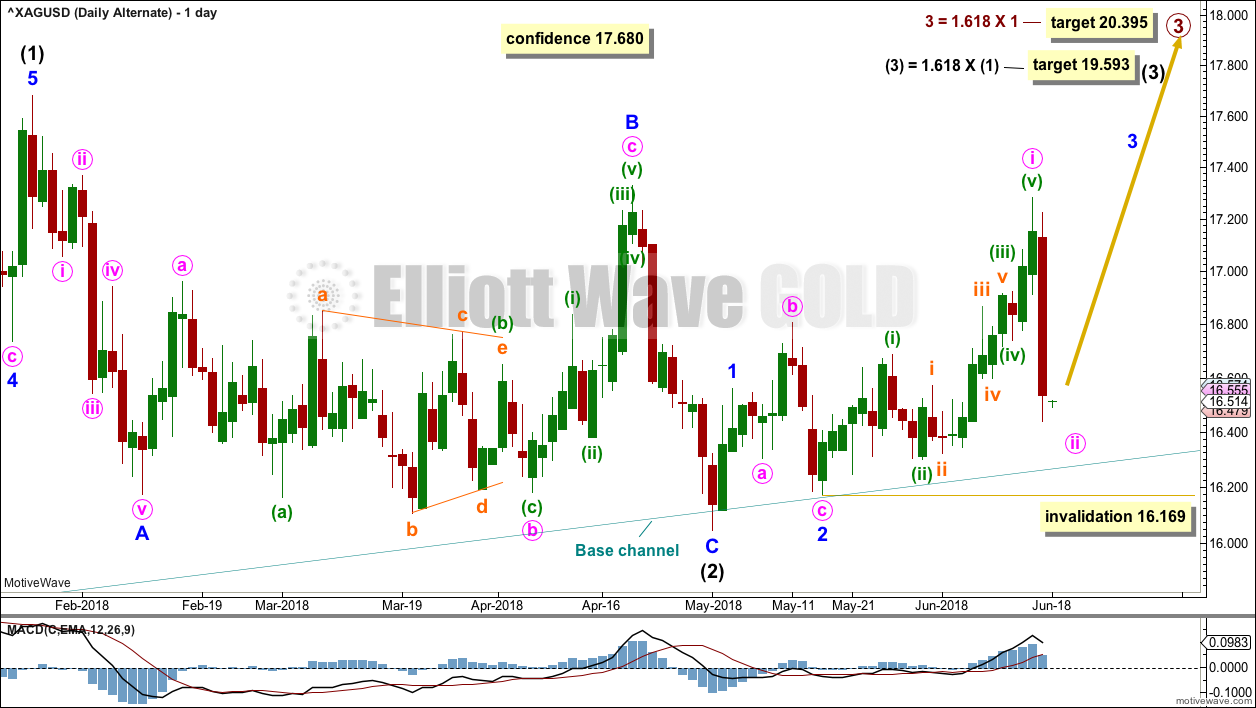Another upwards week fits the main Elliott wave count.
Price moved very strongly lower on Friday but remains above the Elliott wave invalidation point.
Summary: Expect more downwards movement for the short term. Support is strong at the lower edge of the base channel on the alternate wave counts, which is about 16.280.
The target is at 19.593 or 20.395. Volume and On Balance Volume are both bullish. An upwards breakout from a consolidation zone looks likely to happen within a few weeks.
An upwards trend is expected to develop. Use pullbacks as opportunities to join the trend. Look out now for upwards movement to possibly show an increase in momentum.
Always trade with stops, and invest only 1-5% of equity on any one trade.
Last monthly charts can be viewed here.
New updates to this analysis are in bold.
ELLIOTT WAVE COUNTS
MAIN WAVE COUNT
WEEKLY CHART
The first wave count expects that the bear market, which began from the April 2011 high, is incomplete. Although this wave count is presented first, it is not the preferred wave count.
Cycle wave a is seen as a five wave impulse for this main wave count. There are multiple corrective structures possible still for cycle wave b.
This first weekly chart sees cycle wave b as a now possibly complete regular contracting triangle.
Primary wave E of the triangle may have ended with an overshoot of the A-C trend line. If this wave count is correct, then price should have reversed already. Within the new downwards trend, no second wave correction may move beyond the start of the first wave above 17.680.
DAILY CHART
Intermediate wave (1) down subdivides well as a five wave structure.
Intermediate wave (2) may now be complete as a flat correction.
Minor wave B is a double zigzag. All subdivisions fit. However, the purpose of a second zigzag in a double is to deepen the correction when the first zigzag does not move price deep enough. Here, the second zigzag has failed to deepen the correction. This is not technically a truncation, but the effect is the same. This structure makes no sense because it has not achieved its purpose. This must necessarily reduce the probability of this wave count.
At this stage, this first wave count still has the lowest probability of the three wave counts published for Silver.
Within minor wave 3, no second wave correction may move beyond the start of its first wave 1 above 17.283.
SECOND WAVE COUNT
WEEKLY CHART
This is the preferred wave count. It has reasonable support from classic technical analysis, particularly at the weekly chart level.
Cycle wave b may be completing as a double combination: zigzag – X – flat. The second structure, a flat correction for primary wave Y, may be underway.
Within a flat correction, intermediate wave (B) must retrace a minimum 0.9 length of intermediate wave (A) at 15.938. Intermediate wave (B) has met this minimum requirement; the rule for a flat correction is met. Intermediate wave (B) is longer than 1.05 times the length of intermediate wave (A) indicating this may be an expanded flat. Expanded flat corrections are the most common type. Normally their C waves are 1.618 or 2.618 the length of their A waves.
The purpose of combinations is to take up time and move price sideways. To achieve this purpose the second structure in the double normally ends about the same level as the first.
While the combination wave count at the weekly chart level does not currently work for Gold, it does still work for Silver. They do not have to complete the same structures for cycle wave b, and fairly often their structures are different.
Intermediate wave (C) for this wave count is starting out slowly, with deep time consuming second wave corrections. This may indicate very strong upwards movement ahead, with a time consuming and strong impulse to complete.
If minute wave ii continues lower, it may not move beyond the start of minute wave i below 15.525.
DAILY CHART
Minute wave ii looks likely to be over. Minute wave iii may only subdivide as an impulse.
There may now be four overlapping first and second waves complete. A third wave up at four degrees may be expected for this wave count; this should exhibit a strong increase in upwards momentum.
Subminuette wave ii may not move beyond the start of subminuette wave i below 16.169.
SECOND WAVE COUNT – SECOND WEEKLY CHART
This wave count is identical to the Second Weekly Chart above up to the high labelled primary wave W. Thereafter, it looks at sideways movement as a huge triangle labelled primary wave X. This fits very well with MACD hovering about zero.
Cycle wave b may be either a double zigzag or a double combination. Although both of these structures are labelled W-X-Y note that they are quite different and belong to two different families of corrections.
Double zigzags belong to the zigzag family of corrections. Single and multiple zigzags usually have strong slopes against the prior trend. To achieve a strong slope their X waves are usually brief and shallow, most especially brief. Here, primary wave X is not brief, but it is shallow.
Double combinations belong to the sideways group of corrections. The second structure in a double combination (and the third if there is one) exists to take up time and move price sideways. To achieve a sideways look their X waves are usually deep and may be time consuming. Here, primary wave X is not deep, but it is time consuming.
If cycle wave b is a double zigzag, then primary wave Y may move reasonably higher than the end of primary wave W at 21.062 to achieve its purpose of deepening the correction.
If cycle wave b is a double combination, then primary wave Y must subdivide as a flat correction and may end about the same level as primary wave W at 21.062, so that it achieves its purpose of taking up time and moving price sideways.
At this early stage, within primary wave Y, no second wave correction may move beyond the start of its first wave below 16.046.
ALTERNATE WAVE COUNT
WEEKLY CHART
This alternate wave count looks at the possibility that the bear market may be over for Silver and a new bull market may have begun.
A series of three overlapping first and second waves may now be complete for cycle waves I and II, primary waves 1 and 2, and intermediate waves (1) and (2).
A third wave now at three large degrees may be beginning.
Targets calculated for third waves assume the most common Fibonacci ratios to their respective first waves. As price approaches each target, if the structure is incomplete or price keeps rising through the target, then the next Fibonacci ratio in the sequence would be used to calculate a new target.
Within primary wave 3, intermediate wave (2) may not move beyond the start of intermediate wave (1) below 15.525.
The large base channel about cycle waves I and II nicely shows where primary wave 2 found support. It also showed where intermediate wave (2) found support. A lower degree second wave correction should find support (in a bull market) about a base channel drawn about a first and second wave one or more degrees higher. If this base channel is breached at the daily chart level with one full daily candlestick below and not touching it, then the probability of this alternate wave count would be reduced.
Price continues to find strong support about the lower edge of the base channel.
DAILY CHART
Intermediate wave (2) should be over.
Intermediate wave (3) may only subdivide as an impulse.
There may now be almost complete four overlapping first and second waves. This wave count expects to see a strong increase in upwards momentum.
Minute wave ii may not move beyond the start of minute wave i below 16.169. Minute wave ii looks likely to move lower early next week. It should find strong support about the lower edge of the teal base channel, which is copied over here from the weekly chart. That price point is about 16.280.
TECHNICAL ANALYSIS
WEEKLY CHART
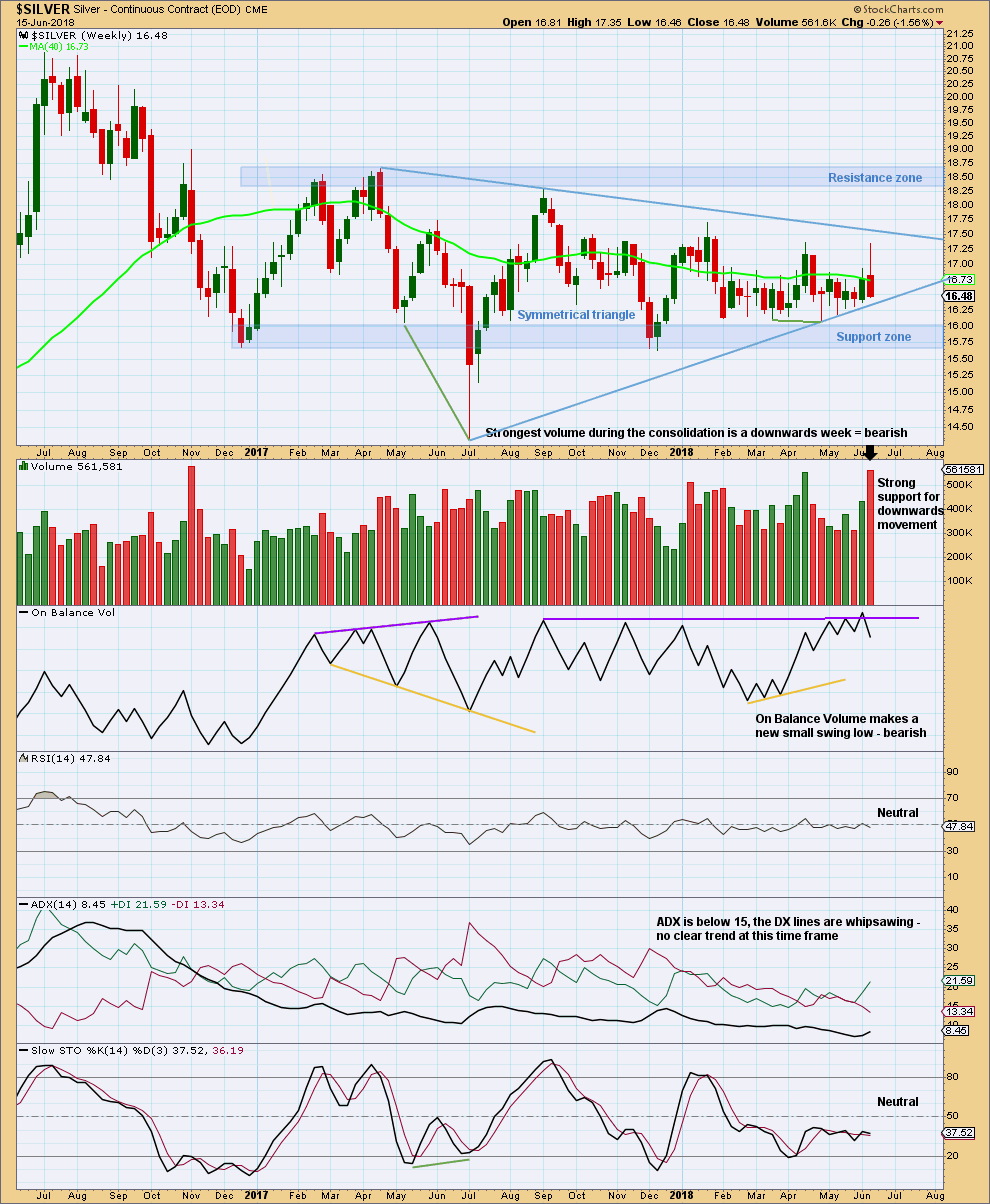
Click chart to enlarge. Chart courtesy of StockCharts.com.
Price continues to find support for the last six weeks about the lower edge of the trend line for the symmetrical triangle. This trend line now has strong technical significance.
The long upper wick of this last weekly candlestick, with support from volume for downwards movement, is fairly bearish.
This last week completes with a higher high and a higher low, but the balance of volume is down and the candlestick is red. Downwards movement within the week is very strong. This is now the strongest volume during the huge consolidation for the triangle, which began back in April 2017. A downwards breakout is now signalled as more likely from the triangle.
Price remains range bound.
DAILY CHART
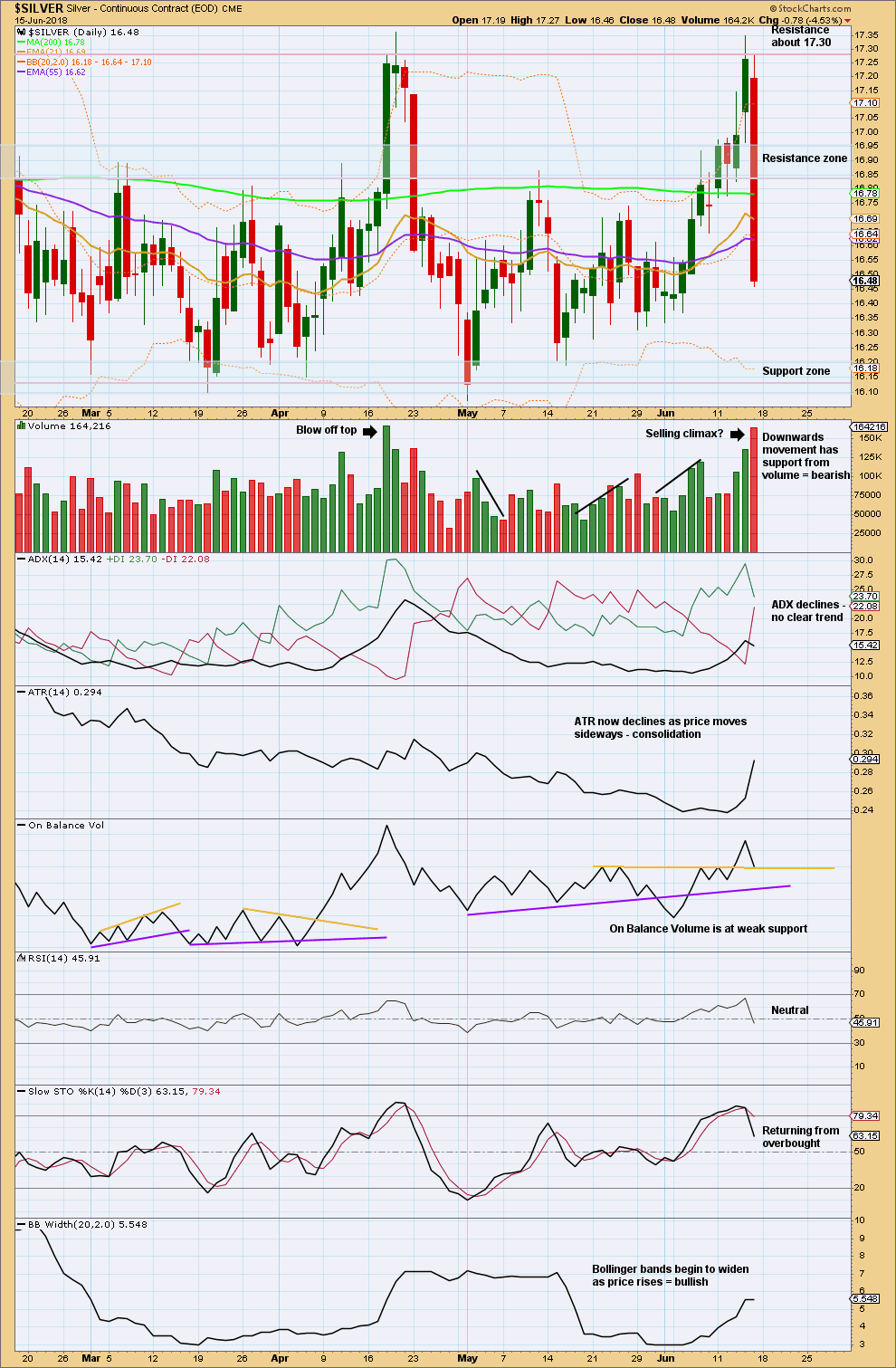
Click chart to enlarge. Chart courtesy of StockCharts.com.
At the daily chart level, the strongest volume is still for the upwards day of the 18th of April, 2018. At this time frame, an upwards breakout is signalled as more likely than downwards. This is a more reliable method than using weekly volume, as the daily volume looks inside the week and may be more accurate.
With no long lower wick and very strong volume for downward movement on Friday, it looks very likely that next week shall see further downwards movement. Look for strong support about 16.20 to 16.10.
Published @ 02:34 a.m. EST on 18th June, 2018.

